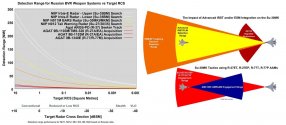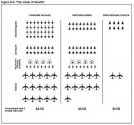Continued... part 2 of 2
The sheer number of the F-35s that will be produced is fundamentally a reflection of the structure of the program and the design of the aircraft intended to make it a more affordable fighter aircraft. This relatively low procurement and operating cost of the F-35 is a strength.... but the sheer number of F-35s that will be bought is also a massive advantage that cannot be matched by any other nation on earth or indeed any other contemporary modern fighter program in the past.
Comparative quantity matters -- at this stage we don't know what the final number of F-35s will be, however the US has indicated it wants to buy nearly 2,500 F-35s for itself. This number may drop depending on how their future force structuring goes, however the sheer number of F-35s that the US itself will field will be very difficult for an opfor to challenge. Let's take the PLA -- of the 5th generartion fighters it will buy overall (including J-20, and J-XY variants) what do we think the total number will be in their lifetime? 1,000? 1,500 perhaps? Or do we think they can reach a total of 2,000 or 2,500?
I raise these hypothetical PLA numbers, because the F-35 itself is individually a qualitatively impressive and capable platform especially in domains of stealth, sensors, networking, payload flexibility, and range, and the stealth/sensors/networking aspect will be even more accentuated the greater the number of fighters that they can deploy at any one time.
To counter these numbers, the PLA can certainly try to pursue semi-asymmetrical routes such as through the use of long range strike systems to attack air bases and so on, to thin out the numbers, however the PLA must also consider that their own air bases will be under attack (as well as likely their production facilities for major military equipment). All this is to say, in terms of the air balance, the PLA's 5th generation fleet may well find itself to be at a significant numerical disadvantage to the opfor's F-35 fleet when all of each side's strike systems and defensive systems are accounted for.
Sure, the J-20 and J-XY as individual platforms might be able to supercruise or accelerate a bit better than the F-35 can. But, would that be enough to make up for the likely disparity in numbers that the J-20 and J-XY will suffer? Furthermore, would the individual qualitative capabilities of the J-20 and J-XY in terms of stealth/sensors/networking be sufficiently competitive against the F-35 as an individual platform either, especially when greater numbers means superior sensing and networking capability as well.
The geographic disposition of F-35s also matters -- simply put, the F-35s of the US will be able to be based in positions around the world where they are capable of striking Chinese economic, political, industrial and military centers, while China's J-20s and J-XYs cannot do the same to the US (aka CONTUS).
Point 4:
This point is pretty simple. The F-35 as a program, brings in many partner nations that essentially are roped into further cementing their status as client states of the US.
The geopolitical benefits of this cannot be measured in dollars or in kilometers of range or Gs pulled or missiles carried. Not only does it mean you have more geopolitical sway over them, but it also means you prevent them from being more geopolitically independent.
Furthermore, there is also one other, major aspect that we cannot forget -- that the F-35s the US's partner nations operate will all be easily operated by the US as well. That is to say, nations that the US sells F-35s to, or partner nations in the F-35 program, can be technically "neutral" in any conflict that the US is involved in, however their fleet of F-35s can be easily repatriated back to the US to replace any losses in US F-35s given the nature of the program means all F-35s will come from the same common line and undergo the same training and logistics system.
=====
In summary, my position is that the F-35 as an individual platform is a very capable multirole aircraft, and in terms of its air superiority role, its advantages and world leading qualitative capabilities in stealth+sensors+networking+payload flexibility+range coupled with the sheer number of the aircraft that will be procured (as a result of its lower procurement and operating cost), far outweighs the compromises in blistering kinematic performance, and that when comparing the overall F-35 fleet and program with the likely 5th generation fleets that can be procured by opposing nations, the F-35 fleet at a system of systems level will prove to be a superior (or at least, a massively challenging) force that can be fielded to attain air superiority, even if an opfor is able to field opposing aircraft that might have slightly superior kinematic capabilities.
The multinational structure of the F-35 program also enables the US to pursue much greater geopolitical sway over its client states in a manner that an alternative, more limited/domestic procurement program may not have allowed, while also allowing the F-35 fleets of its partners/client states to operate as a "technical fleet reserve" that the US will likely be able to repatriate in a very quick manner to replace/augment any wartime losses it suffers.
In context of the realities of the US budget limitations of the last two decades (post cold war and post GFC), I think the pursuit of the F-35 was very much one of the best, if not the best procurement plans the US made in pursuit of its national strategy and in pursuit of its goal in attaining air superiority.
Point 3:Well, let’s stick with the F35 to try to keep it somewhat on topic.
-edited for brevity-
The sheer number of the F-35s that will be produced is fundamentally a reflection of the structure of the program and the design of the aircraft intended to make it a more affordable fighter aircraft. This relatively low procurement and operating cost of the F-35 is a strength.... but the sheer number of F-35s that will be bought is also a massive advantage that cannot be matched by any other nation on earth or indeed any other contemporary modern fighter program in the past.
Comparative quantity matters -- at this stage we don't know what the final number of F-35s will be, however the US has indicated it wants to buy nearly 2,500 F-35s for itself. This number may drop depending on how their future force structuring goes, however the sheer number of F-35s that the US itself will field will be very difficult for an opfor to challenge. Let's take the PLA -- of the 5th generartion fighters it will buy overall (including J-20, and J-XY variants) what do we think the total number will be in their lifetime? 1,000? 1,500 perhaps? Or do we think they can reach a total of 2,000 or 2,500?
I raise these hypothetical PLA numbers, because the F-35 itself is individually a qualitatively impressive and capable platform especially in domains of stealth, sensors, networking, payload flexibility, and range, and the stealth/sensors/networking aspect will be even more accentuated the greater the number of fighters that they can deploy at any one time.
To counter these numbers, the PLA can certainly try to pursue semi-asymmetrical routes such as through the use of long range strike systems to attack air bases and so on, to thin out the numbers, however the PLA must also consider that their own air bases will be under attack (as well as likely their production facilities for major military equipment). All this is to say, in terms of the air balance, the PLA's 5th generation fleet may well find itself to be at a significant numerical disadvantage to the opfor's F-35 fleet when all of each side's strike systems and defensive systems are accounted for.
Sure, the J-20 and J-XY as individual platforms might be able to supercruise or accelerate a bit better than the F-35 can. But, would that be enough to make up for the likely disparity in numbers that the J-20 and J-XY will suffer? Furthermore, would the individual qualitative capabilities of the J-20 and J-XY in terms of stealth/sensors/networking be sufficiently competitive against the F-35 as an individual platform either, especially when greater numbers means superior sensing and networking capability as well.
The geographic disposition of F-35s also matters -- simply put, the F-35s of the US will be able to be based in positions around the world where they are capable of striking Chinese economic, political, industrial and military centers, while China's J-20s and J-XYs cannot do the same to the US (aka CONTUS).
Point 4:
This point is pretty simple. The F-35 as a program, brings in many partner nations that essentially are roped into further cementing their status as client states of the US.
The geopolitical benefits of this cannot be measured in dollars or in kilometers of range or Gs pulled or missiles carried. Not only does it mean you have more geopolitical sway over them, but it also means you prevent them from being more geopolitically independent.
Furthermore, there is also one other, major aspect that we cannot forget -- that the F-35s the US's partner nations operate will all be easily operated by the US as well. That is to say, nations that the US sells F-35s to, or partner nations in the F-35 program, can be technically "neutral" in any conflict that the US is involved in, however their fleet of F-35s can be easily repatriated back to the US to replace any losses in US F-35s given the nature of the program means all F-35s will come from the same common line and undergo the same training and logistics system.
=====
In summary, my position is that the F-35 as an individual platform is a very capable multirole aircraft, and in terms of its air superiority role, its advantages and world leading qualitative capabilities in stealth+sensors+networking+payload flexibility+range coupled with the sheer number of the aircraft that will be procured (as a result of its lower procurement and operating cost), far outweighs the compromises in blistering kinematic performance, and that when comparing the overall F-35 fleet and program with the likely 5th generation fleets that can be procured by opposing nations, the F-35 fleet at a system of systems level will prove to be a superior (or at least, a massively challenging) force that can be fielded to attain air superiority, even if an opfor is able to field opposing aircraft that might have slightly superior kinematic capabilities.
The multinational structure of the F-35 program also enables the US to pursue much greater geopolitical sway over its client states in a manner that an alternative, more limited/domestic procurement program may not have allowed, while also allowing the F-35 fleets of its partners/client states to operate as a "technical fleet reserve" that the US will likely be able to repatriate in a very quick manner to replace/augment any wartime losses it suffers.
In context of the realities of the US budget limitations of the last two decades (post cold war and post GFC), I think the pursuit of the F-35 was very much one of the best, if not the best procurement plans the US made in pursuit of its national strategy and in pursuit of its goal in attaining air superiority.



